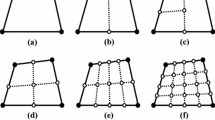Abstract
It is noted that calculations of the interaction between a main crack and two-dimensional microcracks surrounding the main-crack tip can be considerably simplified by using a point-source representation for the microcracks and a self-consistent scheme to determine the strength of these point sources. The procedure is illustrated by a detailed analysis for two basic configurations: (i) a single microcrack of arbitrary orientation near a main crack which is subjected to combined mode I and mode II loading; (ii) two microcracks symmetrically disposed about a main crack which is subjected to purely mode I loading. By comparing the result for configuration (i) with the exact result which is available for the special case of a collinear microcrack, it is found that the point-source representation for that case is accurate to within 5 percent over the range 0 <s/r 1 < 2/3, where 2s is the length of the microcrack and r 1 the distance from the main-crack tip to the mid-point of the microcrack. Over this range of s/r 1, the neutral-shielding angle for configuration (ii), using the point-source representation, is found to vary from 70 to 69.4 deg, when the microcracks are parallel to the main crack.
Résumé
On remarque que les interactions entre une fissure principale et des microfissures bidimensionnelles situées autour de l'extrémité de la fissure principale peuvent être considérablement simplifiées si on représente ces microfissures par des sources ponctuelles, pourvues d'une certaine puissance d'actions. La procédure est illustrée dans les cas de deux configurations: (1) une microfissure simple orientée arbitrairement par rapport à une fissure principale soumise à une sollicitation purement de mode I. (2) Deux microfissures disposées symétriquement de part et d'autre de la fissure principale, soumise à une sollicitation purement de mode I. En comparant les résultats relatifs à la configuration 1 aux résultats exacts disponibles dans le cas spécial d'une microfissure coplanaire, on trouve que la représentation par source ponctuelle est exacte dans ce cas à 5% sur une gamme de s/r1 comprise entre 0 et 2/3, où 2s est la longueur de la microfissure et r1 la distance entre l'extrémité de la fissure principale et le centre de la microfissure. Sur cette gamme de s/r1, et en utilisant la représentation par sources ponctuelles, on trouve que l'angle neutre relatif à la configuration 2 est compris entre 70° et 69°4, lorsque les microfissures sont parallèles à la fissure principale.
Similar content being viewed by others
References
R.G.Hoagland, C.W.Marshall, A.R.Rosenfield, G.Hollenberg and R.Ruh, Materials Science and Engineering 15 (1974) 51–62.
N.Claussen, J.Steeb and R.F.Pabst, Bulletin of the American Ceramic Society 56 (1977) 559–562.
C.C.Wu, R.W.Rice and P.F.Becher, in Fracture Mechanics Methods for Ceramics, Rocks and Concrete, ASTM STP 745, American Society for Testing and Materials, Philadelphia (1981) 127–140.
A.C.Moloney and H.H.Kausch, Journal of Materials Science Letters 4 (1985) 289–292.
W.Kreher and W.Pompe, Journal of Materials Science 16 (1981) 694–706.
A.G.Evans and K.T.Faber, Journal of the American Ceramic Society 64 (1981) 394–398; 67 (1984) 255–260.
R.G.Hoagland and J.D.Embury, Journal of the American Ceramic Society 63 (1980) 404–410.
A.Chudnovsky and M.Kachanov, Letters in Applied Engineering Science 21 (1983) 1009–1018.
A.Chudnovsky, A.Dolgopolsky and M.Kachanov, in Advances in Fracture Research, Proceedings ICF6, Vol. 2, ed. S.R.Valluri et al., Pergamon Press, Oxford (1984) 825–832.
E.Smith, Journal of Materials Science Letters 2 (1983) 204–206.
A.A.Rubinstein, International Journal of Fracture 27 (1985) 113–119.
L.R.F.Rose, Journal of the American Ceramic Society 69 (1986) 212–214.
J.P.Benthem and W.T.Koiter, in Methods of Analysis and Solution of Crack Problems, ed. G.C.Sih, Noordhoff, Leyden (1973) 131–178.
N.I.Muskhelishvili, Some Basic Problems of the Mathematical Theory of Elasticity, Noordhoff, Groníngen (1953).
R.Burridge and L.Knopoff, Bulletin of the Scismological Society of America 54 (1964) 1875–1888.
A.Aki and P.G.Richards, Quantitative Seismology, Vol. 1, W.H. Freeman, San Francisco (1980) chapter 3
B.A.Bilby and J.D.Eshelby, in Fracture, Vol. 1, ed. H.Liebowitz, Academic Press, New York (1968) chapter 2.
R.J.Seyler, S.Lee and S.J.Burns, Advances in Ceramics 12 (1984) 213–224.
G.C.Sih, P.C.Paris and F.Erdogan, Journal of Applied Mechanics 29 (1962) 306–312.
P.F.Byrd and M.F.Friedman, Handbook of Elliptic Integrals, Second edition, Springer-Verlag, Berlin (1971).
B.S.Majumdar and S.J.Burns, Acta Metallurgica 31 (1983) 473–482.
R.M.Thomson and J.E.Sinclair, Acta Metallurgica 30 (1982) 1325–1334.
J.Weertman, I.H.Lin and R.Thomson, Acta Metallurgica 31 (1983) 473–482.
Author information
Authors and Affiliations
Rights and permissions
About this article
Cite this article
Rose, L.R.F. Microcrack interaction with a main crack. Int J Fract 31, 233–242 (1986). https://doi.org/10.1007/BF00018929
Received:
Issue Date:
DOI: https://doi.org/10.1007/BF00018929




